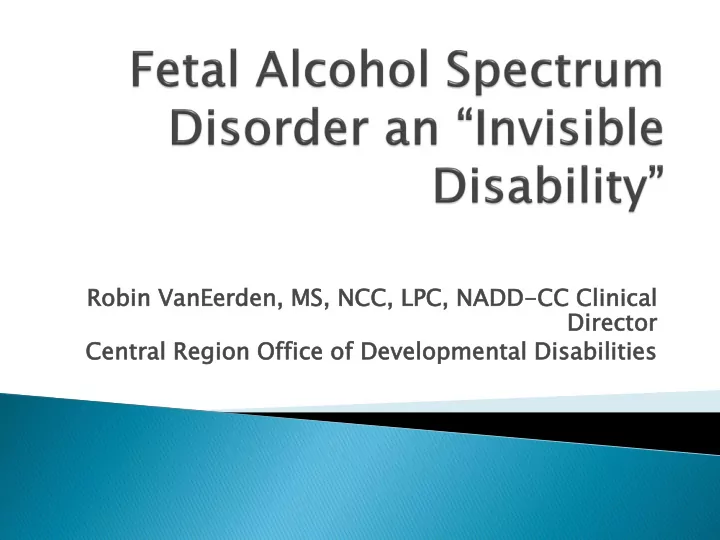

Robi bin VanEer nEerden, den, MS, S, NCC, CC, LPC, C, NAD ADD-CC C Cli lini nical cal Dir irector ector Central ntral Regi gion on Offi fice ce of Deve velopmen lopmental tal Disabil sabiliti ities s
Kills brain cells Distorts the migration of nerve cells Causes abnormal levels of neurotransmitters Interferes with blood flow to the fetus producing oxygen deprivation Interferes with genetic expression and the results may not become apparent until the affected genes are activated at various ages.
One prevented case of FAS saves: $130,000 in the first 5 years $360,000 in 10 years $587,000 in 15 years More than $1 million in 30 years Lupton, Burd, and Harwood (2004)
100% PREVENTABLE
The individual has been diagnosed with a mental health disorder as a preschooler, such as ADHD, oppositional defiance, or bipolar disorder The individual responds to immediate feedback rather than distant consequences such as point or reward systems The individual has received multiple diagnoses and has a history of failed interventions, which may include medication and a range of mental health treatments
The child has been excluded from another preschool program for behavioral issues The child requires “hands on” or visual learning, rather than auditory The child is easily fatigued and overwhelmed by external stimulation The child has difficulty applying what has been learned, and may make the same mistakes over and over The child is a concrete thinker and does not understand metaphors or jokes, etc.
Friendly and outgoing Verbal Helpful Affectionate and lovable Well-intentioned Generous Determined Artistic May be intelligent and have special abilities and skills
Primary Symptoms learning disabilities, deficits in executive functioning, hyperactivity, attention and memory deficits, dysmaturity, sensory challenges Secondary Behavioral Symptoms confused, easily frustrated, easily manipulated, easily fatigued, aggression, anxiety Tertiary Symptoms: running away, involved in the legal system, trouble at home/work/school, multiple diagnosis, self injury,
“ Behaviors ” are a result of a physical-sometimes invisible disability. Damage is permanent but the brain changes during life and so abilities and behaviors may also change. Problems arise when others view behavior symptoms through a lens that assigns judgment and because of a poor fit between needs and environment. This includes targeting behavioral change instead of looking for reasonable and appropriate accommodations in communication, the physical environment, activities, etc. ---FASD Centre--- Failure to recognize the brain based condition leads to effort without results and everyone being frustrated. - --FASD Centre---
Reliance on the use of standard learning theories Lack of understanding and knowledge about FASD
How do we try differently?
Acknowledgement and Understanding that the FASD is the underlying cause of difficulties can decrease anger and frustration Develop the right circle of supports-a trusted, caring group who understands FASD Ongoing training and education for the community, all support members, judicial system, the community, etc. Appropriate and ongoing assessment
FASD SD Interpr erpret etat atio ion Primary deficits: limited ability to understand cause/effect, An individual with an FASD will always need an external executive function. ---Sterling Clarren Possibl ible Strateg tegies ies Trusted group of mentors, coaches, and support staff- that are consistent provide positive feedback and support the person in decision making Interdependence vs. Independence
Visual is King Reasonable Accommodations Who can we actually trust Model and Role Play! Structure-lists, schedules, timers- assisting in managing these aids may always be needed
FASD SD Interpr erpret etat atio ion May on surface appear to understand/agree in order please others, save face but underneath do not fully understand the conversation, direction, etc. Unable to keep track of events and may “ fill in the blanks ” if cornered Possibl ible Str trategi egies es Change the way we communicate concrete-avoid conditional words ( likely/however); keep it simple (1-2 directions at a time);
FASD SD Interpr erpret etat atio ion Possibl ible Strateg tegies ies If the person is frustrated: STOP and try a different strategy Put feelings into words-then help to identify a coping skills (ask for a break/walk away/count to 10 listen to music) Start simple-keep it simple What is the current developmental age(sometimes this fluctuates) and what accommodations are appropriate while still acknowledging and treating the person as an adult.
Who is this person and what are their strengths? curious, artistic, creative, generals, tenacious Accept the difference between can ’ t and won ’ t (and sometimes can one day and can ’ t the next)
“ We must move from viewing the individual as failing if s/he does not do well in a program to viewing the program as not providing what the individual needs in order to succeed.” Dubovsky, 2000
Recommend
More recommend